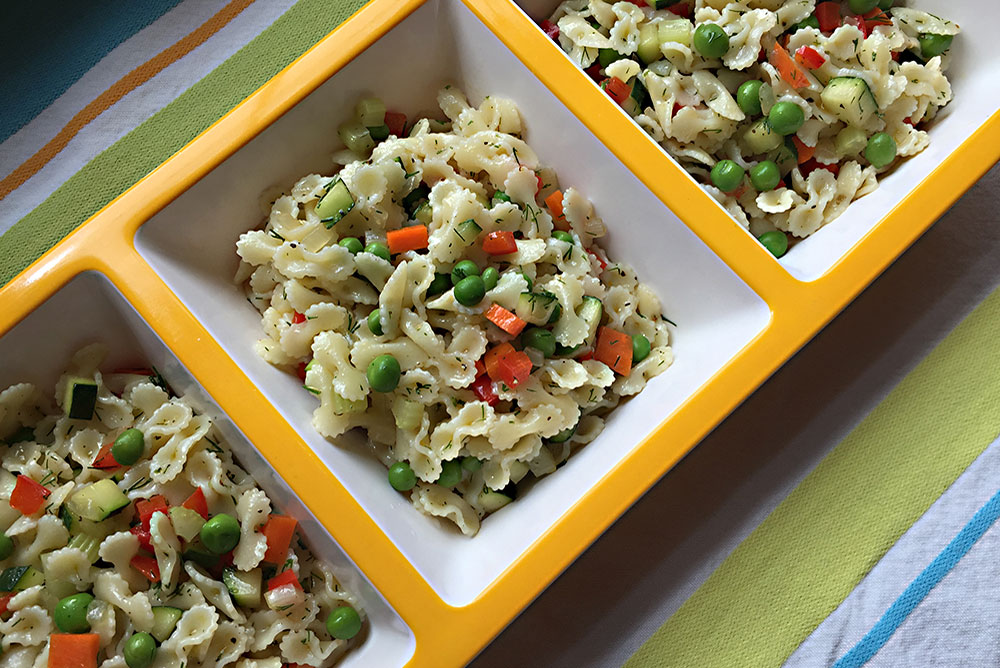
Pasta Salad Primavera. / Photo on the front and above by Stephanie Witt Sedgwick.
I’VE BEEN DEVELOPING and testing recipes for more than 20 years, cooking the dishes at home the whole time. That’s a whole lot of food. Food my family wasn’t always home to eat or wasn’t suited for them. The beneficiaries of this food glut have been my neighbors Cliff and Sandy. While my family approached food photography and testing days with dread, because I was concentrating on cooking for the camera or the recipe rather than for them, Cliff and Sandy were always filled with anticipation. And of the hundreds of dishes I’ve carried across the street, one of their top 10 favorites was easily my Black and White Bean Primavera Salad.
Primavera is a great food word—as an adjective describing food, it means with vegetables in a spring-like way. In reality, spring is slow to deliver any locally grown vegetables, but you get the idea. Lightly cooked vegetables, with or without herbs, are combined with pasta, rice, beans, etc., to make dishes that have the feeling of spring. At the chilly beginning of spring, this may mean a pasta primavera finished with cream and Parmesan cheese. Later, a light pasta salad with a simple dressing of chopped herbs, vinegar and olive oil. Or Cliff and Sandy’s fave, a bean salad. The same ingredients could just as easily become a primavera pilaf or a potato salad primavera.
Whatever the exact dish, in my kitchen, primavera includes a variety of vegetables, some combination of sweet onions, carrots, celery, asparagus, broccoli, peas, zucchini, baby spinach and sweet peppers. I don’t usually have them all on hand at the same time so the combos differ and my primavera is sometimes a clean-out-the-vegetable-drawer dish. Herbs are a wonderful addition; especially when you are keeping the dressings light, they bring a ton of flavor without much fuss.
The methodology for all the variations is the same. Dice, slice or julienne the vegetables and cook everything until just tender, even a little bit on the crunchy side. Combine with the other elements of choice, but remember the vegetables are the stars here. It’s the clean, fresh flavors of the vegetables themselves you’re hoping to highlight.
I’m losing my customers as Cliff and Sandy are downsizing and moving away, but they’ll still have the salad. It’s a recipe they have mastered along with some other versions we’re all fond of. Substitute the vegetables as you please.
- Pasta Salad Primavera: Choose a small pasta such as farfalline, orzo or ditalini. While the pasta cooks sauté equal amounts of diced sweet onion, sweet bell pepper, carrots, celery and zucchini until just tender, seasoning with salt and pepper. In a small pot, cook frozen sweet peas with a little water and salt until just done, then drain. Drain the pasta and rinse with cold water. Combine the cooked vegetables with the pasta, equal parts red wine vinegar and olive oil, chopped fresh herbs (parsley, chives and/or dill) and salt and freshly ground pepper as needed. Taste and add extra vinegar and seasoning as needed. You can refrigerate the salad until ready to serve, but bring to room temperature before serving.
- Black and White Bean Salad Primavera: Sauté equal amounts of diced sweet onion, sweet bell pepper, carrots, celery and zucchini until just tender, seasoning with salt and pepper. In a small pot, cook frozen sweet peas with a little water and salt until just done, then drain. Combine the cooked vegetables with the cooked black and white beans, equal parts red wine vinegar and olive oil, chopped fresh herbs (parsley, chives and/or dill) and salt and freshly ground pepper as needed. Taste and adjust seasonings as needed. You can refrigerate the salad until ready to serve, but bring to room temperature before serving.
And the one Primavera my family always eats (must be the cream and cheese . . . ):
- Pasta Primavera: The classic, the granddaddy of all Primaveras. Steam small florets of broccoli and pieces of asparagus. Sauté sliced sweet onions, sweet bell peppers and julienned carrot with some salt and freshly ground pepper. You could add slices of zucchini, mushrooms, baby spinach and/or cooked peas—it’s up to you. Prepare fettuccine or the pasta of your choice. When the sautéed vegetables are ready, add the steamed broccoli and asparagus. Pour in heavy cream to almost cover the vegetables and add a healthy amount of Parmesan cheese. Let the mixture cook over medium heat for a few minutes until it starts to thicken. Mix with the drained pasta. Top with more freshly ground pepper and Parmesan and enjoy.
—Stephanie Witt Sedgwick
LittleBird “Stephanie Cooks” shares dinner ideas every Monday.
